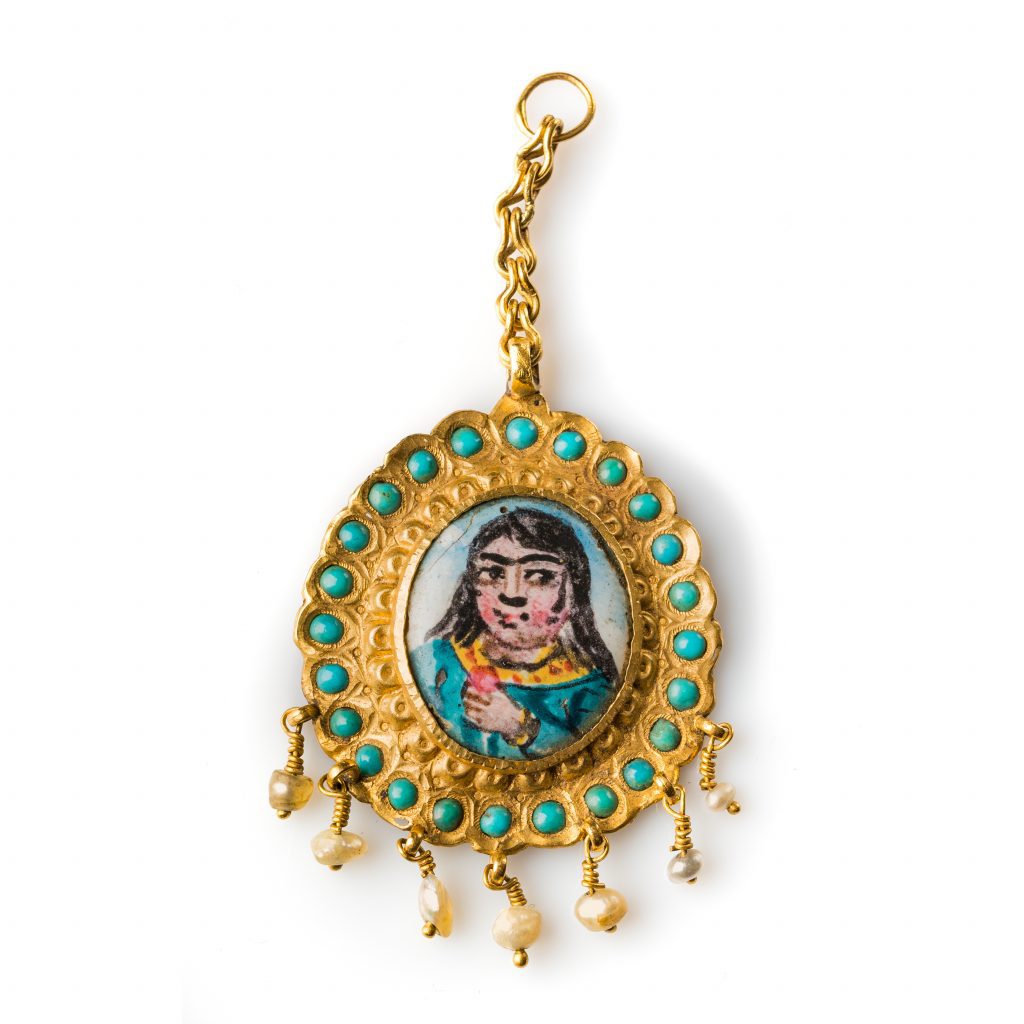Pendant with a Portrait of Muhammad’s Daughter Fatima .Mashhad, Iran, 1860-1870
Painted porcelain, gold, turquoise, pearls
Courtesy of Benjamin Zar-Davidov
For roughly 120 years the Jews of Mashhad in Iran were forced to live as Muslims yet continued to practice their Judaism covertly. Taking advantage of Islamic modesty laws, the Jewish women performed tasks such as carrying ceremonial objects, organizing the men’s clandestine prayer services, and delivering secretly koshered meat.
Benjamin Zar-Davidov (known by his Muslim name, Fathallah Zar) and his wife Sarah lived in Mashhad for 18 months. When she arrived there, Sarah’s mother-in-law gave her clothes similar to those worn by Muslim women and this pendant with a portrait of Fatima, the daughter of the prophet Muhammad. Sarah wore the pendant when she went outdoors to hide the fact that she was Jewish.
Must Know
The pendant shows the image of Mohammad’s daughter, Fatima. The pendant was worn by the Jewish woman in the streets of Mashhad in order to be identified as a Muslim. Masshad is an orthodox Muslim city in Iran. In 1734 the shah of Iran invited a number of Jewish families to live in Masshad in order to manage his treasures. However, not long after the move the Shah was assassinated and the Jews began to suffer from harassment by the Muslims. In 1839, on Eid al-Adha (The Feast of Sacrifice), hundreds of Muslims left the mosque to kill Jews living in the city. After the pogrom, the Jews were given two options: convert to Islam or die. The surviving Jews decided to appear to convert, thus choosing to live. The Jews of Masshad lived in a ghetto and were known as Jadid al-Islam (New Muslims). They lived a double life, outwardly behaving as Muslims whilst privately retaining their Jewish beliefs. On Fridays they went to the mosque and immediately afterwards they conducted the Kiddush at home. They opened their shops on Shabbat, leaving a child in the shop who would tell Muslim customers, “Dad will be back soon”, until the Muslims would get tired of waiting and go to another store. The women played a significant role in preserving Judaism. Muslim women wore the chador (a full-body cloak worn by many Iranian Muslims) which covers the whole body, and thus Jewish women wearing the chador could smuggle the items needed by the community from house to house: prayer shawls, Torah scrolls, Kosher meat and more. In order to prevent intermarriage, at birth every girl was engaged to a member of the community. At the beginning of the 20th century, the Pahlavi Dynasty came to power and issued ID cards to the Masshad Jews, on which they could be registered as Jewish. Over the years, the Jews suffered from continuous harassment, and in 1946, after another blood libel, the remaining Masshad Jews decided to leave the city. Some left for Tehran, Europe and the US, whilst most of them went to Israel.
More Info
The Masshad Jews lived a double life, outwardly as Muslims and as Jews at home. Every person in the community was given two names: one Jewish and one Muslim. When the girls were born, their ears were pierced and they were betrothed to a Jew from the community, so that when they were growing up and the Muslims asked for her hand, she was already engaged and therefore unavailable. The wedding ceremony included a Jewish scripture and a Muslim marriage document. In order not to provoke suspicion, they bought meat and food from Muslim establishments, however they would use it as dog and cat food instead. For Passover they bought bread every day and burned it in a special oven at the entrance of every house. Masshad Jews built hidden mikvahs in their cellars and fulfilled the mitzvah with ice-cold water. After the regular visit to the mosque, the men went to secret synagogues set up in Jewish homes. Masshad Jews used to make pilgrimages to Muslim holy places: Mecca, Karbala and even Jerusalem. However, the Muslims continued to see them as impure and did not allow them to be buried in Muslim cemeteries. This was an important matter for the Masshad Jews and instead, they buried their dead in an allocated cemetery. In 1840, after the pogrom during Eid al-Adha, a large amount of Masshad Jews moved to the city of herat where they were not forced to convert to Islam.

